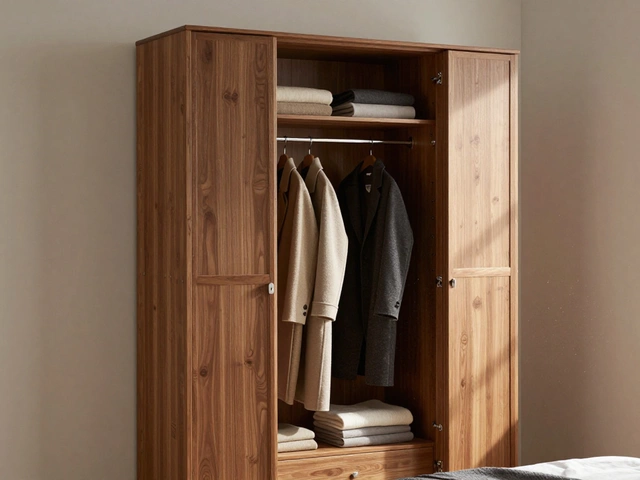We live in a time where purchasing has shifted significantly from traditional store aisles to convenient digital carts. With just a few clicks, you can peruse a wide range of furniture options, compare prices, and read reviews—all from the coziness of your couch. But is this convenience also light on your wallet?
This piece dives into the realm of online furniture buying to evaluate its cost-effectiveness. While the allure of online offers is undeniable, hidden costs and variables like shipping fees and return challenges can make a difference.
Before hitting that 'Buy' button, let's unravel some lesser-known aspects and practical tips to ensure that not only your living space but also your budget, is looking good.
- Understanding Online Furniture Pricing
- Hidden Costs and Delivery Charges
- Quality Assessment from Afar
- Return Policies and Customer Experiences
- Comparing Online Deals with In-Store Offers
- Tips for Navigating Online Furniture Shopping
Understanding Online Furniture Pricing
Buying furniture online can feel like entering a world where prices float like puzzle pieces waiting to be matched. Navigating this virtual realm requires an eye for detail and a knack for comparison. One reason shoppers find online furniture pricing attractive is the wholesale elimination of overhead costs. Without the need for retail space, online sellers often offer competitive pricing, translating to potential savings for the buyer. But shining through these digital aisles can be price discrepancies fueled by dynamic pricing models. These models fluctuate based on demand, inventory levels, and even the time of day—surprising factors that savvy shoppers must keep an eye on.
Factors affecting pricing extend beyond the absence of physical store expenses. The options available can vary significantly from one online platform to the next based on brand exclusivity, material quality, and design trends. It's vital to recognize that cheaper options might skimp on craftsmanship or use less durable materials, leading to shorter life spans for the products. Comparatively, higher-priced items often mirror better build and sustainability, simulating the touch and feel only an actual piece could communicate in stores. To help choose wisely, let reviews from previous buyers be your compass in identifying bargains disguising themselves as deals too good to be true.
Many online retailers employ advanced algorithms capable of tailoring pricing to individual users. Ever noticed how a price subtly shifts after revisiting a listing? This technique, known as personalized pricing, utilizes data collected from your browsing experience, snatching previous searches and purchase history to predict price sensitivity. As unsettling as it may appear, this practice underscores the importance of incognito browsing if seeking the most unbiased price listings.
The digital landscape also encourages fierce competition, promoting seasonal sales and special promotions exclusive to online purchases. Familiarizing yourself with this schedule, coupled with setting browser price alerts, can help you snag that elusive furniture piece at a fraction of its typical cost.
An insightful revelation comes from a 2023 report by the National Retail Federation that reveals, "Neat displays of discounted furnishings consistently lead the queue in e-commerce sales, captivated by the click of mere advertisements." As this trend grows, understanding the variables influencing prices online becomes even more vital.
In this ever-evolving online furniture market, price transparency continues its dance with consumer psychology, inviting us to delve deeper into the costs behind the deals. By equipping yourself with this knowledge, you illuminate the foggy paths of digital buying, ensuring each click brings you closer to an informed decision without sacrificing quality for the sake of savings.
Hidden Costs and Delivery Charges
While the initial sticker price of furniture online may seem tempting, it's vital to dig deeper and consider the often-overlooked hidden costs. One of the primary areas where buyers can find themselves caught off guard is in the realm of delivery charges. Many online furniture retailers advertise low prices only to make up the difference with costly shipping fees, especially for bulky items like couches and dining sets. It's not just about getting a package to your door safely but ensuring that it arrives in a timely manner that aligns with your expectations.
An additional consideration is the potential for delivery fees to increase based on your location. Rural residents might find themselves paying more due to the distance from distribution centers. Even in densely populated urban areas, additional fees might be tacked on for delivery up flights of stairs or other complicating factors. To make informed decisions, savvy customers should always investigate shipping policies before committing to a purchase.
It's worth noting that some retailers, particularly the larger ones, provide the option of free delivery as part of promotional sales. But keep in mind that these deals may come with strings attached, such as minimum purchase requirements or limited geographical range. In some cases, the offer applies only to selected items, which might not include the specific piece you have your eye on. If you encounter promotions, be sure to read the fine print to ensure there are no surprise stipulations lurking beneath the surface.
One respected voice in the industry, John Riley, CEO of Home Decor Innovations, notes,
"In today's marketplace, transparency in delivery fees is paramount. Customers want to feel they're not being nickel-and-dimed once they've made their selection."This sentiment highlights the importance for buyers to remain diligent when exploring checkout screens, as sometimes additional charges might quietly slip through unnoticed until the final price breakdown. Being vigilant can prevent a rude awakening when your credit card statement arrives.
Another critical hidden cost stems from the potential need for assembly or setup after delivery. Many online retailers offer assembly services for a fee—a crucial detail for buyers lacking the time or tools to handle complex instructions. While some may relish the opportunity to wield a wrench and screwdriver, not everyone has the luxury or inclination to do so. Thus, budgeting for assembly costs, if needed, is a key component of accurately assessing the true price of your online furniture purchase.
Finally, returns can present a cost that's hovering just beyond initial purchase contemplation. Most brick-and-mortar stores provide a simple route for returns, a luxury not always extended with online purchasing. Costs can arise from shipping returnable items, restocking fees, or even the logistics involved in packing and sending back a cumbersome item. Understanding a seller's return policy is paramount to avoiding regretful purchases, especially with higher-priced items. A detailed comprehension of each vendor's terms—whether they offer free returns or charge a hefty penalty for change of mind—can significantly influence whether the online option is more cost-effective in the long run.
As the world continues to embrace digital shopping experiences, recognizing these hidden costs and delivery charges becomes an essential skill for every prospective furniture buyer. Balancing these elements with the convenience of online choices can lead to a more satisfying shopping experience without stretching your budget beyond its limits.

Quality Assessment from Afar
Shopping for beautiful furniture online is a marvel. Thousands of choices lie ahead, all curated to ignite your home's aesthetic appeal. However, understanding quality through a screen's pixels can pose quite the challenge. Savvy shoppers must scrutinize images and reviews to discern a product's true craftsmanship. Often, viewing professionally snapped images can veil imperfections that live in physical reality. Thus, reading customer reviews plays a crucial role when attempting to verify the sturdiness and realism of the virtual allure.
The importance of detailed product descriptions cannot be overstated. These descriptions often tell stories beyond what you see; they speak of the unseeable—materials, dimensions, and construction techniques. Words such as solid wood, steel frames, and premium leather indicate longevity and design depth, occasionally bringing peace of mind in your purchase decision. However, relying on product details alone can be limiting—companies may employ appealing language to cultivate a certain image. Thus, a reliable review's substance can lend clarity in an ocean of ambiguity.
Occasionally, it’s prudent to refer to
“third-party reviews and consumer reports, which although not as prevalent in the furniture domain as in electronics, can still offer valuable insights,”as Maggie Stone articulates in her discussion on consumer awareness. For instance, finding a statement that a sofa shows wear within months when it is marketed as 'durable' raises red flags about long-term satisfaction. This blend of both trusting your instincts and seeking peer insights forms the backbone of your assessment strategy.
Don't overlook the potential wealth of knowledge in assembly instructions, often available pre-purchase for certain items. These step-by-step guides expose the nuts and bolts of a piece, hinting at intricacies in assembly and indicative of material robustness. If the manual suggests minimal tools and time, it could allude to simplistic structure, which, while convenient, may signal fleeting durability.
Some online retailers now offer augmented reality (AR) features, allowing customers to visualize items in their space before purchasing. These digital trials offer a contemporary solution to the quality assessment conundrum by helping you gauge the aesthetic compatibility of that retro-modern chair with your teakwood coffee table. While AR brings convenience, it's imperative to note its limitations—textures and color tones can differ in real life, leading to disappointments.
As with everything in the digital age, a fusion of technological tools and human insights forms the best practice. When stepping into the world of online furniture sale, engage cautiously and inquisitively. Embrace reviews, rely on reputable resources, and always maintain skepticism where necessary. Remember: images might speak a thousand words, but only a few will tell the truth of quality.
Return Policies and Customer Experiences
Buying furniture online can feel like entering a magical realm where possibilities are endless, until you encounter a less-than-perfect couch or a dining table with a noticeable blemish. Navigating return policies becomes vital. These policies vary greatly across websites, much like a secret language one must decode before committing to a purchase. Understanding these procedures ahead of time can save a lot of grief later on.
For instance, many online furniture retailers offer return windows ranging from 30 to 90 days, allowing customers to ship back items that don't meet their expectations. Some companies provide free return shipping, while others might charge a fee, so knowing the specifics can make all the difference. Recently, a significant number of buyers expressed frustrations over 'restocking fees,' a term that might sound harmless but could cost up to 20% of the item's purchase price. Potential buyers should scrutinize those conditions as diligently as they would test a mattress's firmness in an actual showroom.
Another factor worth considering is how companies handle damaged goods. Delivery issues are not uncommon, with shipping accidents occasionally resulting in scratches or more severe damage. It becomes crucial for customers to inspect their purchases as soon as they arrive. A piece of advice often shared among seasoned online shoppers is to document any damage with photos immediately—adding weight to your word during the claim process.
"A picture is worth a thousand words, especially when it’s a coffee table arriving with more scratches than you can count,” says Carmen Evans, a seasoned interior designer who often shops for clients online.
Customer reviews offer a goldmine of information about post-purchase experiences. Mining comments and ratings can unveil insights about real-life encounters people have had with the quality of furniture and the effectiveness of return policies. Some buyers have voiced appreciation for retailers who go above and beyond, swapping out faulty furniture swiftly and without added hassle, making the shopping experience feel respected and valued.
In some cases, it can be enlightening to review any available statistics related to customer satisfaction and returns. Consider examining a sample study that showed 28% of online furniture buyers had issues with returns. The percentage, though not staggering, highlights the importance of having adequate knowledge before purchases are made, helping to bridge expectations with reality. It’s about making sure every dollar spent is worthwhile and ensuring that the comfort of your own space reflects your vision without unnecessary entanglements.

Comparing Online Deals with In-Store Offers
When it comes to purchasing furniture, the debate between deciding on an online deal or an in-store offer is a common one. Walking through a furniture store allows you to experience the look and feel of items firsthand. However, online stores often provide a broader range of choices and sometimes more appealing discounts. The art of comparison shopping in both venues requires a discerning eye and a bit of strategy.
It's important to recognize that online furniture retailers frequently operate on a different model than traditional stores. Online platforms typically save on operational costs such as staffing and floor space. They often pass these savings onto consumers by offering lower prices, making online furniture deals increasingly attractive. In contrast, brick-and-mortar stores invest significantly in the ambiance and immediate displays that online platforms can't replicate.
A study conducted by Deloitte indicated that 45% of consumers believe online shopping offers better deals compared to in-store shopping. This belief is not unfounded, as online retailers regularly offer flash sales, discount codes, and loyalty rewards. Yet, a closer look might reveal exceptions, especially concerning high-end designer items. In-store promotions, like those seen during holiday seasons, can sometimes surpass typical online deals. A spine-tingling statistic reveals that retail outlets often offer up to 60% off on showroom pieces, an opportunity many seasoned shoppers find hard to resist.
Despite the potential for better savings online, one should not underestimate the power of seeing and feeling furniture in person. It's here that in-store shopping strikes a vital chord. Not only can you assess the quality and comfort, but you also have the advantage of personalized assistance from sales associates. They can recommend pieces suited to your home style and possibly offer unadvertised deals, tapping into their discretion for additional discounts.
Sometimes, consumers rely heavily on customer reviews when shopping online, which can serve as a proxy for tactile experiences.
According to Richard Solari, an interior design expert, "The best of both worlds is when you combine thorough online research with the direct experience of in-store visits."His advice underscores a hybrid approach, one that many shoppers use to navigate the furniture sale landscape efficiently.
When diving into the specifics of online versus in-store pricing, delivery costs often play a crucial role. Online purchases frequently come with a delivery fee, and while many retailers offer free shipping, this is usually for orders above a certain threshold. In-store purchases might allow immediate collection or offer hassle-free delivery services, sometimes included in promotional deals.
For those who look for both instant gratification and price efficiency, considering a mix of online and in-store shopping might be the way forward. This way, shoppers can balance the tactile pleasures that physical stores offer with the extensive selections and the potential savings available online.
Tips for Navigating Online Furniture Shopping
When diving into the vast sea of online furniture options, it can initially feel overwhelming. However, employing a few strategic tactics can ensure a satisfying and budget-friendly experience. Before you begin, consider defining your needs. Are you looking for a contemporary style or seeking something rustic? Knowing what you want sheds light on where to start your search, and can prevent impulse buys that do not fit your aesthetics or space. Armed with a clear vision, the maze of virtual showrooms suddenly becomes a treasure trove waiting to be explored.
Once you have pinpointed your style, it’s time to get familiar with reviews and ratings, which provide firsthand insights into product quality. Reviews often reveal the truth about comfort and durability more effectively than a picture ever could. Additionally, many seasoned shoppers suggest keeping an eye on detailed product descriptions, paying close attention to dimensions and materials. This is particularly crucial in avoiding the disappointment of ordering a massive table that leaves no space for walking around it in your cozy living room. As wise man once said, “Buying with your eyes closed is like cooking without tasting—both leave room for regrettable surprises.”
Equally crucial is understanding shipping and delivery intricacies. Online deals often boast free shipping, but it’s wise to verify whether it applies to your location. Consider unexpected expenses such as assembly services if the items require setup upon delivery. Comparing such costs across various platforms can unveil the best deal not just in terms of sticker price, but actual total expenditure. A pro-tip is to scout for seasonal sales like Black Friday or New Year discounts, which can offer genuine bargains. These times often see popular stores slashing furniture sale prices, making it the ideal time to purchase that awaited piece without breaking the bank.
Before purchasing, always examine return policies. They vary significantly from retailer to retailer. Some offer generous return windows and free coverage on shipping in case the furniture doesn't meet expectations. By contrast, others might impose stricter terms, leading to unexpected financial setbacks if returns are attempted post-purchase. Keeping tabs on these policies ensures peace of mind, allowing you to make decisions backed by the safety net of reversibility. According to a recent study, about 30% of online shoppers rely heavily on clear return policies before making a purchase, emphasizing its significance in decision-making processes.







